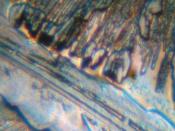Introduction:
Copper(II) sulphate can easily be prepared by reacting copper(II) oxide with dilute sulphuric acid. The resulting copper(II) sulphate solution when cooled can easily crystallize, so the amount of the product can be accurately measured. This lab result can then be compared to the theoretical amount to give a % of the yield calculated. The then Copper(II) sulphate crystals are CuSO4.5H2O.
Hypothesis:
It is my opinion that the results we will receive from the experiments will differ by quite a bit off, by my estimate about 15-25% off the theoretical results one would get by doing the equations of the products sought after. I believe this as the experiment will be taking place in a school laboratory which could cause the apparatuses to cause error or human error could also take place.
Apparatus:
- 1 measuring cylinder (200ml ñ0.1ml)
- 2 Beakers (250ml ñ0.1ml) & larger one
- Filter paper
- Scale
- Funnel
- Bunsen burner
- Heat prove mat
- Stand
Procedure:
1. Collect the Apparatus.
2. Measure out 100 ml (ñ0.1ml) of 2M dilute sulphuric acid (this is the limiting agent) and poor into a 250ml beaker (ñ0.1ml).
3. Warm the acid in the Bunsen burner (DO NOT BOIL).
4. Add copper sulphate until it is in excess ( this can be added in excess as the Sulphuric Acid is the limiting agent which mean.
5. While still warm and using a larger beaker, filter the solution and wash off the residue. Do this with the funnel on a stand so no residue leeks into the solution.
6. Boil the remaining Copper sulphate solution until about 50% of the solution has evaporated.
7. Leave to cool down and crystallize.
8. Dry the crystals between fresh filter papers and when fully dry weigh the results.
Result/Data collection:
Amount of H2SO4:
100cm" of H2SO4 ñ 0.5 cm" ñ 0.5%
The amount of H2SO4 poured into the beaker might not be exact therefore I have put an uncertainties table.
-Collection:
Weight of copper sulphate formed is approximately 38.38g ñ 0.001g.
The color of the copper sulphate formed was blue therefore this implies that the copper sulphate is hydrous.
-Equation:
CuO + H2SO4 CuSO4.5H2O
1 mol. 1 mol. 1 mol.
79.5 g 98.1 g 249.5 g
0.2 M 0.2M 0.2M
15.9g 9.81g 49.9g
2 M of dilute sulphuric acid will contain 19.6 grams of H2SO4
-Calculation of yield data collection
This calculation is done using the amount of the product/solution you have made and the theoretical amount (the amount one should get due to equations) by comparing the 2 one will get the percentage of how close the lab results were to the theoretical results.
% Yield = (actual amount/theoretical amount) x (100/1)
% Yield CuSO4 = (38.38g/49.9g)x(100/1) = 79.91 %
Amount of Copper(II) sulphate crystals:
Final Amount/g ñ 0.001g 38.38
Theoretical Amount/g 159.61
Yield % ñ 0.003% 79.91%
The blue CuSO4 crystals from our experiment turned out to only be 38.38 gramms out of a theoretical 159.61.
Conclusion:
By looking at the table and the calculation it is easy to identify that I hypothesized correctly that our results would be quite a way off the theoretical amount. This can be seen in the Result/Data collection where I did the calculation of yield data collection in which the results show that our results were only 76.91% like the theoretical amount.
Evaluation:
-Errors:
This experiment must have a lot of errors this can be seen by the result data as the Yield % is very far away from being 100% or even anywhere near it. These errors include:
- The filtering process: as we needed to change the filter paper due to clogging, this could have affected the results as the clogging occurred due to already crystallized Copper Sulphate which then stayed on the filter paper and did not get included with the results.
- The filter paper held too much residue (as above), this could also be true for spatulas papers etc.
- We did not evaporate enough water and not everything was crystallized.
- Solution could have leek through the filter paper causing not everything to be filtered.
-Extension:
If I were to do the experiment I would change various things throughout the experiment to get better results than this time. This would include using bigger filter paper so nothing would leek over or crystals would not fall onto the table while drying. Be more careful when moving the crystals or solutions, do the experiment in a different lab where not as many apparatus mistakes would or could happen.
![Copper mining and sulfuric acid plant, Copperhill], Tenn. (LOC)](https://s.writework.com/uploads/5/55187/copper-mining-and-sulfuric-acid-plant-copperhill-tenn-loc-thumb.jpg)
![Copper mining and sulfuric acid plant, Copperhill], Tenn. (LOC)](https://s.writework.com/uploads/6/67737/copper-mining-and-sulfuric-acid-plant-copperhill-tenn-loc-thumb.jpg)
